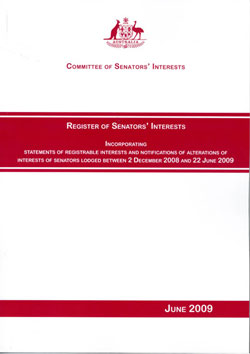Standing Committees
22A Senators’ Interests
-
A Committee of Senators’ Interests shall be appointed at the commencement of each Parliament:
-
to inquire into and report upon the arrangements made for the compilation, maintenance and accessibility of a Register of Senators’ Interests;
-
to consider any proposals made by senators and others as to the form and content of the register;
-
to consider any submissions made in relation to the registering or declaring of interests;
-
to consider what classes of person, if any, other than senators ought to be required to register and declare their interests; and
-
to make recommendations upon these and any other matters which are relevant.
-
-
The membership of the committee shall as closely as possible reflect the composition of the Senate and, until modified by a subsequent resolution, shall consist of 8 senators, 3 nominated by the Leader of the Government in the Senate, 4 nominated by the Leader of the Opposition in the Senate and 1 nominated by any minority groups or independent senators.
-
The nominations of the minority groups or independent senators shall be determined by agreement between the minority groups and independent senators, and, in the absence of agreement duly notified to the President, the question of the representation on the committee shall be determined by the Senate.
-
The committee shall elect as its chair one of its members nominated by the Leader of the Opposition in the Senate.
-
The quorum of the committee shall be 3 members.
-
The chairman may from time to time appoint a member of the committee to be deputy chairman, and the member so appointed shall act as chairman of the committee when there is no chairman or the chairman is not present at a meeting of the committee.
-
Where votes on a question before the committee are equally divided, the chairman, or the deputy chairman when acting as chairman, shall have a casting vote.
-
The committee shall have power to send for persons or documents, but shall not exercise that power, nor undertake an investigation of the private interests of any person, except in accordance with a decision agreed to by not less than 3 members of the committee other than the chairman.
-
The committee shall have power to confer with a similar committee of the House of Representatives.
-
The committee shall, as soon as practicable after 31 December in each year, prepare and table in the Senate a reporton its operations during that year, and shall also have power to report from time to time.
Amendment history
Adopted: 17 March 1994, J.1425–27, as SO 22A
Amended: 24 August 1994, J.2053 (to take effect 10 October 1994) (an opposition senator designated as chair)

The Committee of Senators' Interests monitors the operation of the Senate's resolutions on the registration of interests
Commentary
The Committee of Senators’ Interests was established to supervise the operation of the Senate’s new resolutions requiring the registration of senators’ interests, adopted on the same day after a long period of gestation. While the House of Representatives had adopted a system of registration 10 years earlier following the change of government in 1983, there had been resistance in the Senate on the grounds that the proposed system was unlikely to be effective. There had been several reports on the issue but no action until, in the aftermath of the so–called “sports rorts affair” involving the resignation of a minister over the administration of a program of community cultural, recreational and sporting grants, the resolutions were adopted as part of a package of accountability measures.[1] See Odgers’ Australian Senate Practice, 12th edition, pp.136–37 and 355, for background to the adoption of the resolutions and analysis of the committee’s powers and composition.
At the time of the committee’s establishment, the Procedure Committee was already undertaking a major inquiry into ways in which the Senate committee system could be made more responsive to the composition of the Senate. The proposal contained in the government’s notice of motion for a six member committee (comprising three government, two opposition and one minority group or independent senator) and a government chair was modified by opposition amendments that attempted to anticipate the outcome of the Procedure Committee’s inquiry. The size of the committee was increased to eight (comprising three government, four opposition and one minority group or independent senator) and the chair was left to the choice of the committee, on which non-government senators now had a majority. In addition, the standing order contained an explicit statement that the composition of the committee was to reflect the composition of the Senate as closely as possible.[2]
Also removed from the proposed terms of reference was a paragraph conferring on the committee the function of advising on changes to a non-existent code of conduct. All parties agreed that it was pointless to retain inoperative provisions.
When the Procedure Committee presented its report on the committee system a short time later, the Senators’ Interests Committee was one of the committees selected to have an opposition chair. Paragraph (3) was amended accordingly.
Despite the new quorum provisions intended by the Procedure Committee to apply to all committees, the Senators’ Interests Committee retained its specific provision for a quorum of three, which could allow the committee to meet with representatives of only one of the major parties present. In practice, this has not proved to be a concern, nor has the special decision-making provision applying to the exercise of inquiry powers (three other than the chair), which could theoretically be invoked by opposition members only. When the size of the committee was increased by amendment to the original motion, consequential amendments to address the quorum arrangements were not moved.